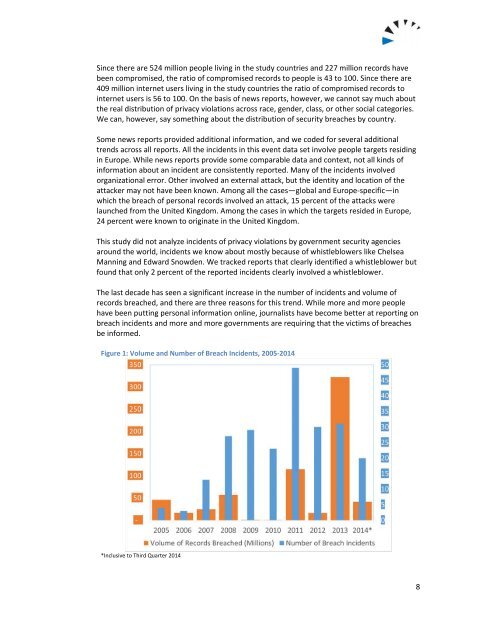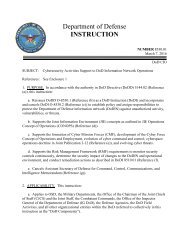data-breaches-in-europe
data-breaches-in-europe
data-breaches-in-europe
Create successful ePaper yourself
Turn your PDF publications into a flip-book with our unique Google optimized e-Paper software.
S<strong>in</strong>ce there are 524 million people liv<strong>in</strong>g <strong>in</strong> the study countries and 227 million records have<br />
been compromised, the ratio of compromised records to people is 43 to 100. S<strong>in</strong>ce there are<br />
409 million <strong>in</strong>ternet users liv<strong>in</strong>g <strong>in</strong> the study countries the ratio of compromised records to<br />
<strong>in</strong>ternet users is 56 to 100. On the basis of news reports, however, we cannot say much about<br />
the real distribution of privacy violations across race, gender, class, or other social categories.<br />
We can, however, say someth<strong>in</strong>g about the distribution of security <strong>breaches</strong> by country.<br />
Some news reports provided additional <strong>in</strong>formation, and we coded for several additional<br />
trends across all reports. All the <strong>in</strong>cidents <strong>in</strong> this event <strong>data</strong> set <strong>in</strong>volve people targets resid<strong>in</strong>g<br />
<strong>in</strong> Europe. While news reports provide some comparable <strong>data</strong> and context, not all k<strong>in</strong>ds of<br />
<strong>in</strong>formation about an <strong>in</strong>cident are consistently reported. Many of the <strong>in</strong>cidents <strong>in</strong>volved<br />
organizational error. Other <strong>in</strong>volved an external attack, but the identity and location of the<br />
attacker may not have been known. Among all the cases—global and Europe‐specific—<strong>in</strong><br />
which the breach of personal records <strong>in</strong>volved an attack, 15 percent of the attacks were<br />
launched from the United K<strong>in</strong>gdom. Among the cases <strong>in</strong> which the targets resided <strong>in</strong> Europe,<br />
24 percent were known to orig<strong>in</strong>ate <strong>in</strong> the United K<strong>in</strong>gdom.<br />
This study did not analyze <strong>in</strong>cidents of privacy violations by government security agencies<br />
around the world, <strong>in</strong>cidents we know about mostly because of whistleblowers like Chelsea<br />
Mann<strong>in</strong>g and Edward Snowden. We tracked reports that clearly identified a whistleblower but<br />
found that only 2 percent of the reported <strong>in</strong>cidents clearly <strong>in</strong>volved a whistleblower.<br />
The last decade has seen a significant <strong>in</strong>crease <strong>in</strong> the number of <strong>in</strong>cidents and volume of<br />
records breached, and there are three reasons for this trend. While more and more people<br />
have been putt<strong>in</strong>g personal <strong>in</strong>formation onl<strong>in</strong>e, journalists have become better at report<strong>in</strong>g on<br />
breach <strong>in</strong>cidents and more and more governments are requir<strong>in</strong>g that the victims of <strong>breaches</strong><br />
be <strong>in</strong>formed.<br />
Figure 1: Volume and Number of Breach Incidents, 2005‐2014<br />
*Inclusive to Third Quarter 2014<br />
8
















